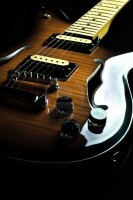No, I’m not referring to making pig noises with the guitar. What I’m talking about is pinch harmonics. Anyone who has heard any Zakk Wylde licks will know what I’m talking about. I have had a lot of students ask about how to make that sound over the years, so I thought it was time to just write a short lesson on it. In this lesson, I will first elaborate more on what pinch harmonics are, the proper technique for making pinch harmonics, and some practice recommendations for them.
What are harmonics?
When you play a note on the guitar, you are actually playing a set of frequencies that blend together creating the overall sound of that note. You simply hear what is called the fundamental frequency, which is the lowest frequency of vibration along the string, more than the other frequencies. A harmonic is simply a note created by amplifying or preventing vibration of a certain overtone, which is a frequency that is higher than the fundamental frequency. Great, so what does all this mumbo jumbo mean?
Well to create a harmonic, you have to adjust your playing to amplify or prevent an overtone. There are many ways to do this, including the often-used amplifier feedback. For our purposes we are focusing on the way you are actually playing using your hands. There are two types of harmonics: natural and artificial. Natural harmonics are created from the open strings only, since this would be considered the “natural” state of the string. Fretting a string and thereby shortening the vibrational length of the string produces artificial harmonics. This is where pinch harmonics fall in.
How do I play a pinch harmonic already?
While some people fear this is a difficult technique, it is actually quite simple. Proper execution of the technique is where most people have trouble. To create a pinch harmonic, you are simply going to hit the string with the pick and your right hand (or left hand if playing a left-handed guitar) thumb at the same time, or simply adjust the position of your thumb against your pick so that the skin of your thumb will hit the string immediately following the pick. Starting out, it will help to use high gain distortion on your guitar provided either by a pedal or your amp. This will help to bring out the harmonics more. As we discussed earlier, artificial harmonics are done by shortening the vibrational length which means your harmonic positions change depending on the note you are fretting. Try moving your hand around the picking area for each note to find the different harmonic frequencies available for each note.
Practicing Pinch Harmonics
Starting out, you’ll want to use high gain distortion and your bridge pickup when working on pinch harmonics. This will make it easier to make them come out. Pay attention to where on the string you’re picking with each fret to learn where each harmonic spot is. Once you start to get the hang of “pinching,” you’ll want to switch to using a clean sound during practice. I read an article by Zakk Wylde once, where he talked about one of his early guitar teachers showing him how to do pinch harmonics and made him practice them with the clean channel on the guitar. What it did was force him to really work to get the harmonics to pop out, and as a result he learned where the best spots were on the strings depending on what note was being fretted. While practicing on the clean channel will help, starting out that way can be a bit frustrating for some people as it is harder to get the harmonics to come out. So make it more satisfying; start out with some distortion and make that guitar squeal!
